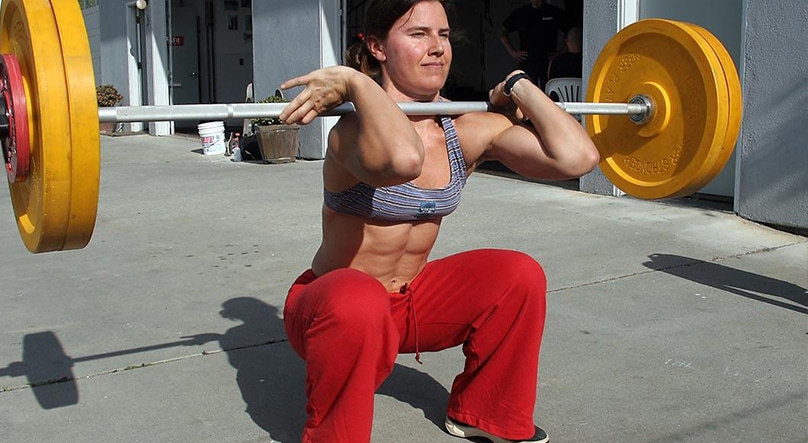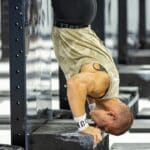Your everyday, non-training posture has a far greater impact on our athletic performance and mental and physical health than you probably realize.
Sure, you know it’s bad to slouch and that we should stand up straight when walking, but do we know why that’s the case? I bet if you knew what poor posture was doing to your mood and how it was limiting you in the gym, you’d pay much closer to attention to the way you were sitting and walking. Fortunately, this article explains just that.
Jump to:
- How does poor posture come about?
- The biggest cause of poor posture stems from prolonged sitting
- Muscle and joint damage
- It also affects your heart and other organs
- Don’t forget about your mood!
- What’s all this doing to your athletic performance?
- What good posture looks like and how to get there
- Stretches to help you achieve good posture:
How does poor posture come about?
Sometimes poor posture is the result of accidents and injuries. But more often than not, sloppy posture arrives out of environmental factors and bad habits that are entirely within our control.For example, simply hunching over to stare at your phone at a 60 degree angle can place more than 60lbs of pressure on your cervical spine. Yikes.
Other factors tied to the onset of poor posture include poor sleep support (a bad mattress), being overweight, occupational stress, muscular imbalances, improper shoes and walking and standing with bad form. With regards to walking and standing properly, walking expert Jonathan FitzGordon writes, “ Walking correctly is essentially the act of falling forward and catching yourself over and over all day long. As the body is propelled through space, the brain will tell the back leg to step forward to prevent us from face planting. This is how it should go.
But, for whatever reason, most people tend to lean backward slightly with legs that move forward before the trunk so that the rest of the body has to be pulled along to catch up.” Indeed, even standing with good posture can be a problem for many people—we should look to keep ourselves properly aligned with the legs under the pelvis and the spine lined up directly above it.
Based on our testing, this is the best creatine for most people. It has the perfect dosage of creatine monohydrate per serving, which has been proven to increase muscle mass.
- Promote strength and muscle gains
- Tested for purity and safety
- Creatine has no known side effects
When we walk or stand incorrectly, our bones and muscles are lined up incorrectly, which blocks the flow of the sciatic nerve (a nerve that connects the spinal cord with the leg and foot muscles). Such a blockage can result in sciatica, a condition that causes pain in the back of the thigh, calves and even the feet.
The biggest cause of poor posture stems from prolonged sitting
. A 2012 study from the International Journal of Behavioral Nutrition and Physical Activity found that, on average, people spend 64 hours a week sitting, 28 hours standing, and 11 hours lounging around regardless of whether or not they exercised 150 minutes a week.That’s over nine hours of sitting a day. Prolonged sitting invariably leads to slouching, and comes with a host of other problems that are typical of poor posture, which include…
Muscle and joint damage
When you’ve been seated for an extended period of time, you begin to slouch. This leads to a ton of stress landing on the muscles of your lower back—particularly those of the posterior chain. When that happens, the spine’s natural arch is exaggerated, leading to a condition called hyperlordosis. When we sit on our butts, our glutes become weak and they lose their primary role of hip stabilization and extension. In fact, by remaining seated for most of the day, your hip flexors are rarely extended and they become short and tight, thus limiting your range of motion. Weak glutes are a real problem when it comes to our stability and producing powerful hip extension, which means a lot of our lifts at the gym will be directly affected by spending so many hours sat in a chair/couch. And don’t forget how much pressure is placed on your cervical spine, neck, and shoulders when you look down at the computer screen or your phone. The damage to your muscles and joints is only enhanced at the gym if you let poor posture dictate your movement patterns. Imagine how much stress must be placed on your bones, muscles, and joints if you can’t keep a vertical spine during a back squat, or if you have a poor front rack position as a result of internally rotated shoulders (thanks to slouching). Yes, those mechanical faults can be attributed to poor form, but a lot of the time it’s a sign that your body is trying to compensate for bad posture. Over time, this can lead to muscular imbalances, as well as injury.
It also affects your heart and other organs
Dr. Joel Goldthwait was the founder of the orthopedic clinic at Massachusetts General Hospital in Boston in the early 20th century. When performing surgery, he noticed that “abdominal nerves and blood vessels are under tension in individuals whose bodies are out of alignment,” as is reported by ‘Energy Medicine; the Scientific Basis’ by James Oschman. Dr. Goldthwait also noticed that people with ‘faulty body mechanics’ (i.e. bad posture) displayed various cardiac problems that impaired circulatory efficiency. Goldthwait goes on, but you get the picture. Your posture directly impacts how well your body is able to move your blood, which is especially worrying considering how many vital nutrients (like oxygen) it carries to crucial systems (like your muscles). Slow blood flow allows fatty acids to clog the heart, which causes high blood pressure and elevated cholesterol. It can also cause blood and other fluids to pool in the legs, which can lead to varicose veins and the formation of dangerous blood clots called deep vein thrombosis. Poor posture can also affect your digestion and breathing and places a lot of strain on your heart. A study published in the August 2007 issue of the “Journal of Neuroscience” suggests that strain in the neck muscles may contribute to higher blood pressure. In addition, the lack of decent blood flow means that there won’t be many nutrients flowing to the brain, slowing our cognitive function and potentially leading to serious health problems—such as a stroke.
Don’t forget about your mood!
A study published in Health Psychology in June of this year studied what effect slumped or straightened posture had on the hearts and minds of 74 people in New Zealand. The participants were strapped into their respective postures (slumped or straight) with tape, then had their blood pressure and heart rates measured as they completed several tasks to assess their mood and self-esteem (the tests included a reading task and the Trier Social Stress speech task). The results? “Upright participants reported higher self-esteem, more arousal, better mood, and lower fear, compared to slumped participants. Linguistic analysis showed slumped participants used more negative emotion words, first-person singular pronouns, effective process words, sadness words, and fewer positive emotion words and total words during the speech. Upright participants had higher pulse pressure during and after the stressor. Conclusions: Adopting an upright seated posture in the face of stress can maintain self-esteem, reduce negative mood, and increase positive mood compared to a slumped posture. Furthermore, sitting upright increases rate of speech and reduces self-focus,” study authors wrote.
What’s all this doing to your athletic performance?
Let’s recap: Poor posture can lead to damaged joints, bones muscles, stressed organs—including the heart, with blood flow, in particular, becoming inefficient—and a more negative mood and lower self-esteem than proper posture. In a high-intensity, constantly varied program such as CrossFit, athletes need to ensure that their body is healthy and operating properly to ensure good recovery and progress in their fitness and mental well-being. Poor posture directly interferes with that.
What good posture looks like and how to get there
Correct sitting posture:
Ideally, you want your head to be in a neutral position looking straight ahead; This can be a problem if your computer is on the desk below you, so find a way to raise your monitor up to eye level as this will keep your head in line with your torso and take the strain off of your neck and shoulders. Your shoulders should be relaxed with your elbows at your sides and bent 90 degrees. Your forearms should be parallel to the floor. If you are working on a computer, position the keyboard so that you can reach it without having to bend your elbows. Don’t lean forward with your chest, instead tilt your pelvis forward just slightly so that you’re sitting on your hamstrings rather than completely on your glutes. You can use the chair as a backrest, but try to avoid leaning back into it. Your feet should be flat on the floor—not cross-legged, as that can lead you to slouch.
Correct standing posture:
From the American Chiropractic Association
– Bear your weight primarily on the balls of your feet.
– Keep your knees slightly bent.
– Keep your feet about shoulder-width apart.
– Let your arms hang naturally down the sides of the body.
– Stand straight and tall with your shoulders pulled backward.
– Tuck your stomach in.
– Keep your head level-your earlobes should be in line with your shoulders. Do not push your head forward, backward, or to the side.
– Shift your weight from your toes to your heels, or one foot to the other, if you have to stand for a long time.
Stretches to help you achieve good posture:
Downward-facing dog
Downward-Facing Dog is a yoga pose that stretches the calves, hamstrings, glutes and muscles along the spine. To start, go on to all fours. Place your hands under your shoulders and position your knees hip-distance apart from each other. Lift your hips up and back, and relax your head in between your arms. Hold this stretch for three to five breaths. Do not practice this pose if you have a shoulder or wrist injury.
Hip Flexor (Samson) Stretch
This is a great stretch to correct anterior pelvic tilt and enable greater range of motion in the hips. Begin in a lunge position with your torso upright. Be sure to have one knee directly below your hip and the other leg forward with your knee directly above your ankle. From this starting position, clench your abdominal muscles. Squeeze your ass to prevent your hips from extending forward. Be sure that your front knee does not extend past your front foot, and hold this stretch for 20-30 seconds before repeating with the opposite leg.
Foam Roller Bridge
Lying on your back, place your arms out to the side, and externally rotate your palms so that they face the sky. Position your heels on a foam roller in front of you (hips knees and feet all in alignment). From this position, tilt your pelvis and pull your bellybutton down into the floor, ensuring you eliminate any space in the small of the spine. Keeping the roller still, start to drive up through the heels, all the while maintaining your body alignment. Make sure your glutes are squeezed as you drive up, keeping the emphasis through the bottom and legs, rather than the lower back. Hold at the top for five seconds before slowly returning to the starting position.
Thoracic Spine Opener
Lie on your side and bring the knee of the leg that’s NOT on the ground to a slightly-above 90-degree angle close to your stomach (the knee should be resting on the ground). From this position, extend your top arm straight out and try to touch the ground on the opposite side of you. Open up your chest as you do so and try to keep your shoulders on the ground.














